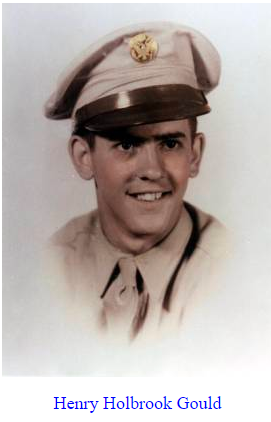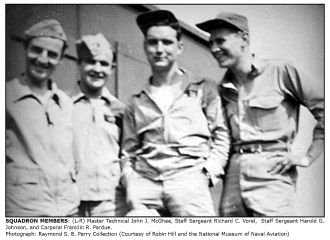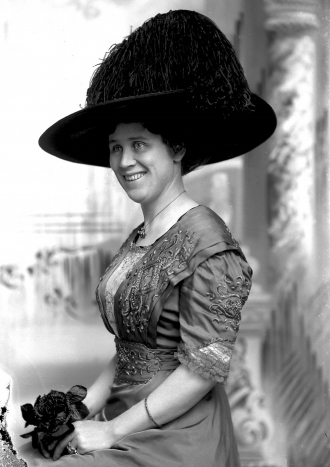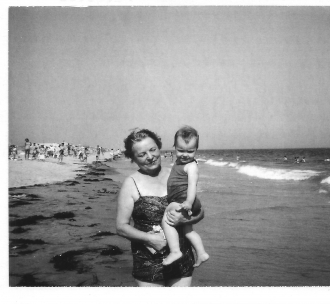Henry Holbrook Gould - born in 1926 Woonsocket, Rhode Island
Henry Holbrook Gould was born in Woonsocket, Rhode Island in 1926. In December of 1943 he was a senior at Woonsocket High School and the captain of the basketball team. In early 1944, he would turn eighteen and be drafted into military service. His older brother Warren had joined the Navy two years earlier and his uncle had been captured on Battan in the Pacific. He entered the Army March 21st and arrived at Fort Devens, MA on April 1st. At Devens he learned the basic ropes and regiment of the military He traveled by train to basic training with the Air Corps at Keesler Field, Mississippi. In a letter home he noted they received their rifles, a Remington bolt action 9-1/2 lbs. The 03-A3 was a modified Springfield WW-I design used early in the war before the supply of Garands was plentiful. The 03-A3 was also used in training. As with other weapons several manufactures would produce weapons under license to attain the large quantities needed. The Springfield 03-A4 saw use as a scoped sniper rifle. He also noted, in a letter home, that he had a perfect score on the target range with a pistol and liked the sub machine gun. Unfortunately, he found the carbine lacking “couldn’t hit the side of a barn door with it.” He also noted The U.S. Army never retreats, It advances to the rear. He then joined the 84th Infantry Division “Railsplitters” June 5, 1944.
Originally in WW-I the 84th was from Illinois, the “Lincoln Division” later the Railsplitters. In WW-II the 84th started out in Texas at Fort Howze and then moved to Claiborne Louisiana to complete its training. While many in the 84th were from the west the division filled out its ranks 15,000 of them, with men from all across the US. At Claiborne B Company drilled, marched, and trained some more. In letters home he mentioned training under fire when, somehow another GI set off a mine (and this was just training). They trained at night, in swamps, and with tanks and gliders. Most from the 84th will tell you of their new rifles in August, because they were full of grease and needed to be cleaned. In mid August he earned the Expert Infantry Badge, the forerunner of the Combat Infantry Badge, which is earned in combat, under fire.
A sample of the stationary from Kessler Field and Camp Claiborne
Training in the summer of 1944 in Louisiana, for a New England boy was terribly hot. He often mentioned the stifling weather, constant heat rash, and monstrous thundershowers.
On leave at the end of May. With his father, Robert D. Gould, brother Charles and Rusty. Uncle Charlie would later serve with the Marines in Korea.
These six fellows are from Company L of the 333 Regiment, Third Battalion, 84th Infantry. In front (left to right) are Vince Loguidice and Greg Tarpinian. Standing, are Howard Hyle, Robert Rachofsky, Bill Long, and John Guerry.
Here the L Company men are ready for battle. (Photos courtesy of Dan McCullen)
In the front are Vince Loguidice, and Bill Chantry. In the rear Dan McCullen, Bill Long, Bill McClain, and Howard Hyle. True to the 84th’s odds in the early days Robert Rachofsky was killed in action, John Guerry was wounded, Greg Tarpinian, Vince Loguidice, Dan McCullen, Bill Long and Howard Hyle were captured.
INFANTRYMAN
In WW-II the infantry was the backbone of the army. Eighty percent of the men in the division served as infantrymen. Military Occupational Specialty (MOS) 745, rifleman. As was written in The Men of Company K, when you look at a battle map with its fronts and salients and see that arrow indicating the advancement of the unit, at the very point of that arrow is the infantry man. In 1944, with his rifle and what else he can carry, he brings the battle to the enemy, much as he did for the last hundred years.
Click to see equipment
For organization of an Infantry Division click here
The 84th traveled by train to Camp Kilmer in New Jersey for final preparation to sail for Europe. Many Railsplitters were able to see New York City, which was nearby prior to departing. About the time the 84th was about to sail the details were secret and the letters home censored.
On September 20, 1944, the 334th Infantry Regiment was aboard the Thomas Barry troop ship headed for action. Other elements of the 84th were aboard the Sterling Castle and E. B. Alexander. Conditions aboard ship were quite crowded and the food, if you could keep it down, took some getting used to. The Thomas Barry arrived in South Hampton on October 1st.
Many of the Railsplitters were able to see London during their stay in England. While London had been bombed heavily the major landmarks survived. London offered many other special services to soldiers a long way from home.
Date & Place:
Not specified or unknown.


 Debby Stevens
Debby Stevens 





